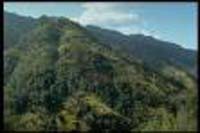'Lost World' in remote Indonesian jungles
Soon after scientists landed by helicopter in the mist-shrouded mountains of one of Indonesia's most remote provinces, they stumbled on a primitive egg-laying mammal that simply allowed itself to be picked up and brought to their field camp for observation. Describing a "Lost World", apparently never visited by humans, members of the team said Tuesday they also saw large mammals that have been hunted to near-extinction elsewhere and discovered dozens of exotic new species of frogs, butterflies and palms.

"We've only scratched the surface," said Bruce Beehler, a co-leader of the monthlong trip to the Foja Mountains, an area in the eastern province of Papua with roughly 2 million acres of essentially pristine tropical forest. "There was not a single trail, no sign of civilization, no sign of even local communities ever having been there," he said, adding that two headmen from the Kwerba and Papasena tribes, the customary landowners of the mountain range, accompanied the rapid survey expedition.
"They were as astounded as we were at how isolated it was," he told The Associated Press in a telephone interview from Washington, D.C. "As far as they knew, neither of their clans had ever been to the area." The December expedition was organized by the U.S.-based environmental organization Conservation International and the Indonesian Institute of Sciences. It was funded by several organizations, including the National Geographic Society.
Minutes after the small team of U.S., Indonesian and Australian scientists were dropped into a boggy lakebed and set up camp near the mountain range's western summit, they said they encountered a new species of bird, a red-faced and wattled honeyeater. The next day they saw Berlepsch's Six-wired Bird of Paradise, described by hunters in the 19th century and named for the wires that extend from its head in place of a crest.
They watched in amazement as a male bird performed a courtship dance for an attending female, shaking the long feathers on his head, and later took the first known photograph of the bird. The scientists said they discovered 20 frog species including a tiny microhylid frog less than a half-inch long, four new butterfly species, and at least five new types of palms.
Though their findings will have to be published in scientific journals and then reviewed by peers before being officially classified as new species, other environmentalists said the discoveries were hardly surprising in a country renowned for its rich biodiversity.
"There are many species that have not been identified" in Indonesia, said Chairul Saleh of the World Wild Fund for Nature, which has made hundreds of its own discoveries in the sprawling archipelago in the last 10 years. Papua, the scene of a decades-long separatist rebellion that has killed an estimated 100,000 people, is one of Indonesia's most remote regions, geographically and politically, and access by foreigners is tightly restricted.
The scientists said they needed six permits before they could legally visit the mountains located on the western side of New Guinea island. Stephen Richards of the South Australia Museum in Adelaide said he and other team members got a glimpse of what the island "was like 50,000 years ago, because there's been no hunting, no impact of transport or anything like that."
Among their most memorable experiences were their encounters with Long-beaked Echidnas, members of the primitive egg-laying group of mammals called the Monotremes, which twice allowed themselves to be picked up and brought to the camp for survey.
Beehler attributed their unwariness to the fact that they probably had never come into contact with humans. But other animals, like the Golden-mantled Tree Kangaroo, an arboreal jungle-dweller new for Indonesia and previously thought to have been hunted to near extinction, were much shier, he said, and quickly disappeared into the dense old-growth forest after being spotted.
Because of the rich diversity in the forest, the group rarely had time to stray more than a few miles from their base camp. Beehler, vice president of Conservation International's Melanesia Center for Biodiversity Conservation, said he hopes to return later this year with other scientists.
One of the reasons for the rain forest's isolation, he said, was that only a few hundred people live in the region and game in the mountain's foothills is so abundant that they had no reason to venture into the jungle's interior. There did not appear to be any immediate conservation threat to the area, which has the status of a wildlife sanctuary, he said.
"No logging permits are given to this area, there is no transport system, not a single road," Beehler said. "But clearly with time everything is a threat. In the next few decades there will be strong demands, especially if you think of the timber needs of nearby countries like China and Japan. They will be very hungry for logs", reports the AP.
N.U.
Subscribe to Pravda.Ru Telegram channel, Facebook, RSS!


